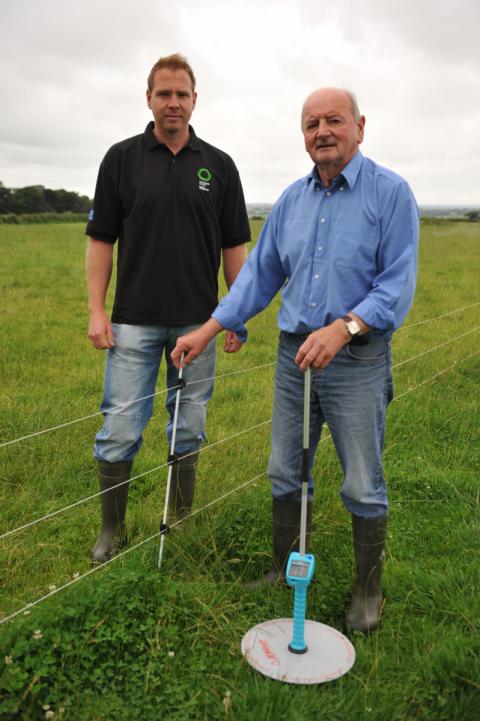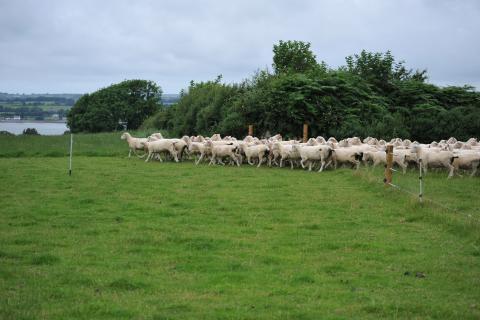Switching to rotational grazing from a set stocking system is allowing a Welsh sheep farmer to increase his stocking rate by 25%.
Alwyn Phillips, who runs two performance-recorded pedigree flocks of Texels and Poll Dorsets near Caernarfon, is bucking the trend with his approach to grassland management, proving that a change in mindset can yield big advantages to business performance.
By splitting fields into one hectare paddocks – known as cells - he is seeing a big improvement in grass quantity and quality. This is enabling him to increase ewe numbers by 100, to 500.
The initial set-up cost of the system was £341.79/ha (£136.72/acre) and included 2500 metres of Kiwitech semi-permanent electric fencing and 1200 metres of water pipe but it is estimated that it will pay for itself in under two years.
Mr Phillips, a Farming Connect Focus Farmer, first saw cell grazing in operation in New Zealand and knew it could work on his farm. “I could see how good grassland management could maximise the potential of our superior genetics,’’ he recalls.
He has been recording his flock on grass since 1980 and says the ability of lambs to convert grass into meat is different to that of those converting compound feed. “My Texels have one of the highest muscle EBV in the breed – the top 1% for muscle is 3.49 mm and my best rams are 7.15 mm- but I cannot compete with the 20-week weight EBV for growth against lambs on continuous creep feed. To improve my lamb growth, I knew I had to improve my grassland management.’’
Mr Phillips commissioned James Daniels, of Precision Grazing Ltd, to design and install a rotational grazing system on four fields covering 24 hectares (59 acres) at Pengelli Farm. The area was divided into 24, 1ha cells.
Feed budgets were modelled using estimated grass growth figures to determine potential stocking rate and required rotation length. This allowed the required number and area of cells to be calculated. “This was then adapted to fit within the chosen fields and the location of the mains electric fence energiser and water supplies,’’ says Mr Daniels.
Fields were sub-divided with semi-permanent fences; power and water was routed via central lane fences to the outlying cells. In the two fields with the best quality leys the cells were sub-divided with polywire and temporary fibreglass posts; these can be removed easily for making silage. “The sub-division of the other fields was achieved using semi-permanent fibreglass posts that support high tensile steel wire. A high tensile spring arrangement allows the wires in the fences to stretch,’’ says Mr Daniels.
“This means that if an animal comes into contact with the wire, the fence absorbs the impact rather than breaking. It also means that the fence can be pegged down and stock or vehicles moved over the top, saving time and reducing the need for permanent gateways.’’
Sheep must be trained to use the system but this takes just two days. “Training is crucial because once they get bad habits it is difficult to stop those,’’ says Mr Phillips. “We did this by ensuring fence voltage was a minimum of 7000V and quickly returning any animals which challenged the fence back to the flock. We didn’t have any problems after that but we regularly test the fence to ensure voltage stays above 5000V.
“When we move them into fresh grazing we just peg the fence onto the ground because the steel wires stretch. The sheep just step over the wires because they learn that by doing this they have access to fresh grazing.’’
Portable troughs, which are designed to be easily emptied and towed by hand or behind a vehicle, are moved from cell to cell with the sheep. These are simply connected to the water pipes that run on the surface via a special hydrant.
The rotational grazing system at Pengelli is stocked at 4lu/ha (8 ewes/acre) with peak stocking rate exceeding 6lu/ha (12 ewes/acre) in July when 8ha was taken out of the rotation for silage. The sale of finished lambs will reduce the stocking rate to 2.5lu/ha (5 ewes/acre) by November in preparation for the winter rotation of deferred grazing and silage. “The 100 ewe flock expansion would have required an extra 8 hectares (20 acres) of land under Mr Phillips’ traditional grazing system. Assuming an area of this size was available locally to rent this would substantially increase his costs. Instead, he has made a capital investment in infrastructure which will add value to his land,’’ says Mr Daniels.
Research has shown that rotational grazing systems result in an increase of 2300 tonneDM/ha of utilised grass which, based on AHDB figures, has a value of £99.00ha/year.
“The increased number of ewes will provide an estimated £8,700 increase in gross margin. This is without any additional benefits such as increased lamb growth rates and improved pasture composition,’’ Mr Daniel explains. “The system will be paid back in under two years.’’
The grass is measured weekly by Mr Phillips and Gethin Davies, of Farming Connect, and sent to Precison Grazing Ltd who analyse the figures and respond within 24 hours with a management plan. For this service, Mr Phillips is charged a monthly management fee which is based on the system area. “It means that we know where we are going to be with the grazing system in three or four weeks’ time, what cells need fertiliser, what needs to be cut and when we need to move the stock,’’ says Mr Phillips.
“We would aim to go into a field at a grazing height of 2000kgDM/ha and exit at 1400-1500 but it has been such an exceptional growing season we are going in at 2500.’’
Not only is the system allowing Mr Phillips to grow more grass with a high concentration of clover but also reduce fertiliser inputs. He applied 50kg/acre of 22-6-8 Cut and Graze on May 10 on all paddocks and a further 75kg on June 25th to the 8ha (20 acres) of silage ground.
When grass growth exceeds demand multiple cells can be taken out for silage because the fencing is easy to remove and reinstate.
Mr Phillips runs up to five different groups of sheep at any one time which he says demonstrates that rotational grazing is as suitable for complicated systems as simple ones. “We manage it so that the priority groups get the best grazing, for example the weaned lambs will graze ahead of the dry ewes.
“The grazing management on this system has got to be right with sheep because unlike dairying we don’t have the safety net of buffer feeding, there are fewer options. The requirements also change with weaning and flushing, there are lots of variable factors that complicate the system.’’
Mr Phillips now aims to establish a rotational grazing system for his herd of 40 mostly pedigree Limousin beef cattle next year.
Farming Connect will run a progression event at Pengelli later this summer to allow farmers to see the system in operation and will follow this with an open day in the winter.
Mr Phillips says the main reason for adopting this system was to lower the cost of production of his lambs. “With each 1kgDM of grazed grass costing roughly a quarter that of bought in concentrates, it makes sense to optimise the farm’s grass growing potential. My ram customers value this grass-based approach, because they are producing prime lambs off grass as well. What we have achieved here shows that it is. There is a perception that it is a lot of extra work but once the sheep are trained it is really very simple, provided you have a well-designed system.’’
* Farming Connect has created a network of ‘Focus’ sites across Wales to provide farmers and foresters with the opportunity to see first hand the latest innovative practices, solutions and integrated approach tools which can support the future development of their businesses.


